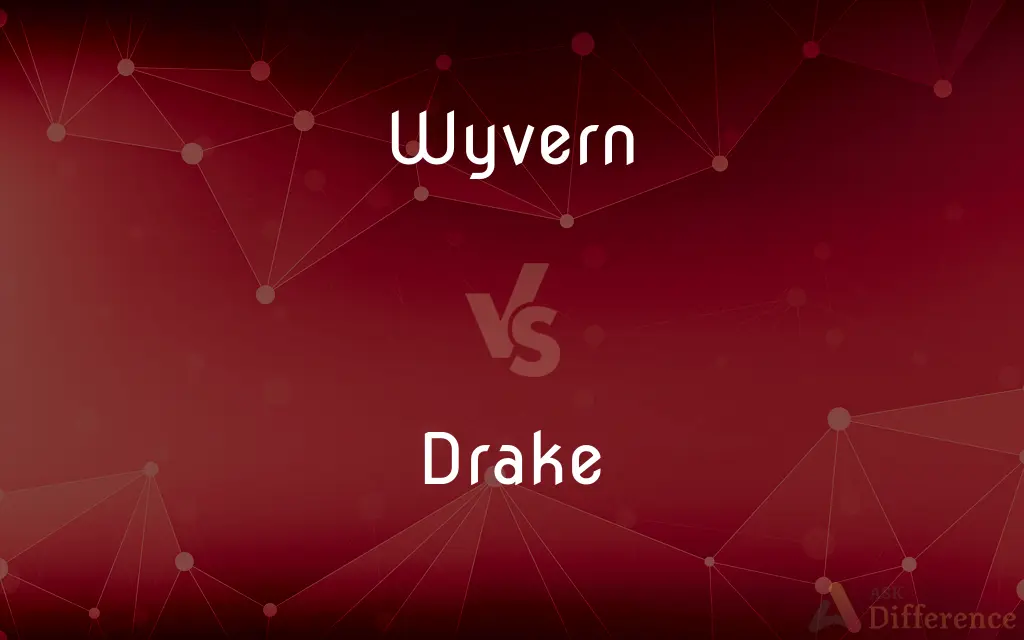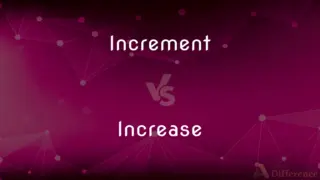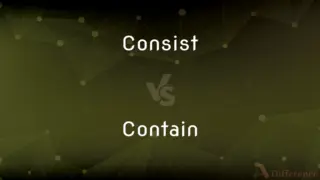Wyvern vs. Drake — What's the Difference?
By Tayyaba Rehman & Fiza Rafique — Updated on March 3, 2024
Wyverns are mythical creatures with two legs and wings, often depicted in European folklore, while drakes are dragons with four legs, sometimes wingless, varying widely in mythology.

Difference Between Wyvern and Drake
Table of Contents
ADVERTISEMENT
Key Differences
Wyverns, depicted in medieval European heraldry and folklore, are dragon-like creatures characterized by their two-legged design and a barbed tail, often associated with fire-breathing abilities and malicious intent. In contrast, drakes are a broader category of dragons, typically shown with four legs and may or may not have wings, depending on the cultural context or specific mythology. While wyverns are often depicted in roles of guardians or threats, drakes can vary greatly in their portrayal, from benevolent and wise to fierce and destructive.
The wyvern's imagery is frequently used in heraldic symbols and flags, representing strength, protection, and sometimes malevolence. Drakes, on the other hand, appear in various mythologies and stories, from Norse legends to English folklore, and their characteristics can differ significantly. They can embody earthy attributes, treasure-guarding habits, or even serve as mounts or companions to heroes.
One of the key distinctions between wyverns and drakes lies in their physical appearance, particularly the number of legs and the presence of wings. Wyverns' two-legged stance and winged form make them distinct within the dragon family, suggesting agility and air dominance. Drakes, with their more traditional four-legged dragon appearance, might be perceived as more grounded and powerful, often depicted as larger and more intimidating.
In literature and modern fantasy, wyverns and drakes serve various symbolic and narrative roles. Wyverns, with their sleek and menacing appearance, are often used to convey danger or to serve as formidable obstacles for protagonists. Drakes, given their varied interpretations, can be allies, sources of wisdom, or significant threats, allowing for a wider range of storytelling possibilities.
Wyverns and drakes reflect the diverse ways in which dragons have been imagined and reimagined across different societies. The wyvern, with its specific form and attributes, represents a narrower interpretation of dragon mythology, often tied to European traditions. Drakes, embodying a broader category, reflect the universal appeal and adaptability of dragon lore, appearing in countless stories and myths around the world.
ADVERTISEMENT
Comparison Chart
Legs
Two
Four, sometimes shown without wings
Wings
Yes
Varies; may have wings or be wingless
Origin
European heraldry and folklore
Diverse mythologies, including Norse and English
Symbolism
Strength, protection, malevolence
Varies; can represent wisdom, earth, or treasure-guarding
Use in Heraldry
Common, especially in flags and symbols
Less common
Role in Stories
Guardians, threats
Allies, wise creatures, threats
Appearance
Sleek, agile, often with a barbed tail
Larger, more grounded, varying features
Cultural Significance
European traditions
Global, across various cultures
Compare with Definitions
Wyvern
Associated with strength and malevolence in heraldry.
The family's banner bore a wyvern, a sign of their formidable lineage.
Drake
Reflects the universal appeal and adaptability of dragon lore.
Tales of drakes appear in cultures around the world, each with its unique twist.
Wyvern
Often depicted as a guardian or a menacing threat.
Legends tell of a wyvern guarding the lost treasures of the old kingdom.
Drake
Appears in diverse mythologies, with characteristics that can include wisdom or ferocity.
In the saga, the hero sought the wisdom of a wise old drake.
Wyvern
A mythical creature with two legs and wings, often found in European folklore.
The castle's crest featured a wyvern, symbolizing its ancient protectors.
Drake
Can embody earthy attributes or serve as treasure guardians.
The drake, entwined with roots, awoke as the thieves approached its lair.
Wyvern
Represents air dominance and agility.
The wyvern soared above the battlefield, casting shadows over the armies below.
Drake
A term for dragons, often with four legs and varying in the presence of wings.
The ancient drake slept beneath the earth, guarding its hoard of gold.
Wyvern
Characterized by its dragon-like appearance and barbed tail.
The knight faced a wyvern in the mountain pass, its barbed tail whipping fiercely.
Drake
Sometimes depicted as mounts or companions in stories.
The warrior rode into battle atop a fierce drake, feared by all who saw them.
Wyvern
A wyvern ( WY-vərn, sometimes spelled wivern) is a legendary bipedal winged dragon usually depicted with a tail ending in a diamond- or arrow-shaped tip.The wyvern in its various forms is important to heraldry, frequently appearing as a mascot of schools and athletic teams (chiefly in the United States, United Kingdom, and Canada). It is a popular creature in European literature, video games, and modern fantasy.
Wyvern
A two-legged dragon having wings and a barbed tail.
Wyvern
A draconian creature possessing wings, only two legs and usually a barbed tail.
Wyvern
Same as Wiver.
Common Curiosities
Do drakes appear in specific cultural mythologies?
Drakes appear in various cultural mythologies, including Norse and English folklore, with their characteristics and roles varying widely.
How are wyverns used in modern fantasy?
In modern fantasy, wyverns are used as agile and dangerous creatures, serving as obstacles or menacing threats in stories.
What symbolic roles do drakes play in literature?
Drakes can symbolize wisdom, strength, guardianship, or treasure-guarding, serving as allies, sources of wisdom, or significant threats.
Can drakes have wings?
Yes, some drakes are depicted with wings, though others are shown as wingless, emphasizing their connection to the earth or other elements.
Is the wyvern's appearance symbolic of anything?
The wyvern's sleek and agile appearance can symbolize air dominance, agility, and the potential for both protection and threat.
How does the portrayal of drakes differ from wyverns in stories?
Drakes are often portrayed as more varied and complex than wyverns, with roles that can range from benevolent guides to formidable adversaries.
What distinguishes a wyvern from other dragons?
Wyverns are distinguished by their two-legged stance and winged form, often associated with a barbed tail and malicious intent.
Are wyverns always depicted as evil?
While often associated with malevolence, wyverns can also represent strength and protection, especially in heraldic contexts.
Are there historical or real-world inspirations for wyverns and drakes?
Both wyverns and drakes draw inspiration from historical, cultural, and mythological sources, reflecting humanity's long fascination with dragon-like creatures.
What makes wyverns unique in dragon mythology?
Wyverns are unique for their specific two-legged and winged design, which sets them apart from the broader category of four-legged dragons or drakes.
Share Your Discovery

Previous Comparison
Increment vs. Increase
Next Comparison
Consist vs. ContainAuthor Spotlight
Written by
Tayyaba RehmanTayyaba Rehman is a distinguished writer, currently serving as a primary contributor to askdifference.com. As a researcher in semantics and etymology, Tayyaba's passion for the complexity of languages and their distinctions has found a perfect home on the platform. Tayyaba delves into the intricacies of language, distinguishing between commonly confused words and phrases, thereby providing clarity for readers worldwide.
Co-written by
Fiza RafiqueFiza Rafique is a skilled content writer at AskDifference.com, where she meticulously refines and enhances written pieces. Drawing from her vast editorial expertise, Fiza ensures clarity, accuracy, and precision in every article. Passionate about language, she continually seeks to elevate the quality of content for readers worldwide.















































